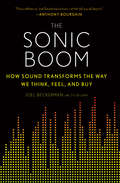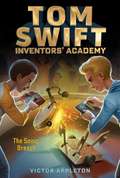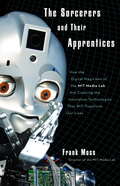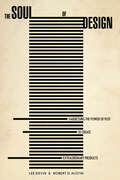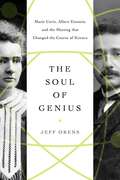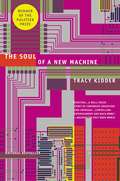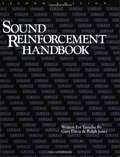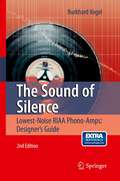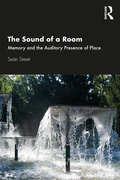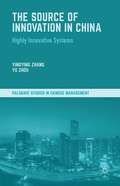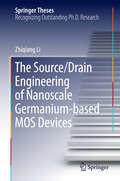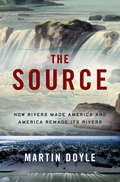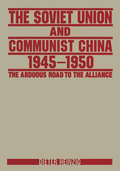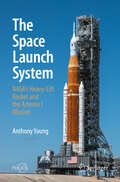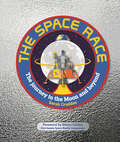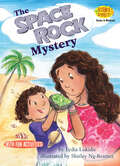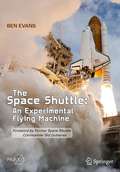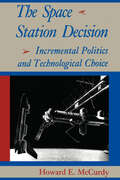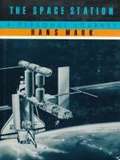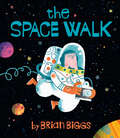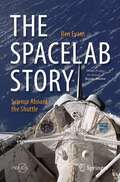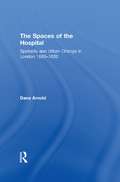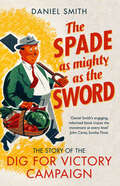- Table View
- List View
The Sonic Boom: How Sound Transforms the Way We Think, Feel, and Buy
by Tyler Gray Joel BeckermanA fascinating study on the influence of sound—and how companies wrangle its power to affect our moods, our shopping habits, and our lives. From movie scores and national anthems to cell-phone dings and squeaky shoes, sound and music impact how we perceive the stories, situations, and products we encounter every day. In The Sonic Boom, composer and strategic sound expert Joel Beckerman reveals sound&’s surprising power to influence our decisions, opinions, and actions in ways we might not even notice: discordant ambient noise can induce anxiety; ice cream truck jingles can bring you back to your childhood. You don&’t need to be a musician or a composer to harness the power of sound. Companies, brands, and individuals can strategically use sound to get to the core of their mission, influence how they&’re perceived by their audiences, and gain a competitive edge. Whether you&’re a corporate giant connecting with millions of customers or a teacher connecting with one classroom of students, the key to an effective sonic strategy is the creation of &“boom moments&”—transcendent instants when sound connects with a listener&’s emotional core. &“Equal parts sociological study and business advice, using unique everyday examples—for instance, how the fate of the Chili&’s fajita empire rested on the sound of the sizzling platter, and how Disneyland approaches soundscapes for a fully immersive experience—to explain how sound effects our mood and shopping habits.&” —Entertainment Weekly &“Music defines us. Joel Beckerman knows. Let him tell you all about it.&” —Anthony Bourdain &“The Sonic Boom reveals the music and structured cacophony of everyday life.&” —Moby
The Sonic Breach: The Drone Pursuit; The Sonic Breach; Restricted Access; The Virtual Vandal (Tom Swift Inventors' Academy #2)
by Victor AppletonThe Hardy Boys meets Alex Rider in this second novel in a brand-new series starring everyone’s favorite inventor—Tom Swift!Tom gets to take all sorts of cool classes at the Swift Academy of Science and Technology, but robotics may be the one he is most excited for. Their teacher is holding a battling robot tournament, and Tom has to build a machine that will come out on top. With the final battle coming up, Tom and his friends need as much time as possible to refine their masterpiece. But the rest of their teachers have been giving so many pop quizzes that they can barely focus in class, never mind concentrate on the tournament. Naturally, everyone is frustrated with the trend…until a mysterious new phone app appears. If students get pop quizzes during first period, they can warn everyone else about it by getting their phones to emit a high-pitched sound—a mosquito alarm—that adults can’t hear. Tom is unsure about the whole thing, but it technically isn’t cheating, right? But when someone changes the app to break all the rules, the ethics aren’t debatable anymore. The longer the perpetrator remains unknown, the more harshly teachers treat all the students, and the pressure won’t stop until Tom and his friends track down the person behind the app takeover.
The Sorcerers and Their Apprentices
by Frank MossIf you've ever read a book on an e-reader, unleashed your inner rock star playing Guitar Hero, built a robot with LEGO Mindstorms, or ridden in a vehicle with child-safe air bags, then you've experienced first hand just a few of the astounding innovations that have come out of the Media Lab over the past 25 years. But that's old hat for today's researchers, who are creating technologies that will have a much deeper impact on the quality of people's lives over the next quarter century. In this exhilarating tour of the Media Lab's inner sanctums, we'll meet the professors and their students - the Sorcerers and their Apprentices - and witness first hand the creative magic behind inventions such as: * Nexi, a mobile humanoid robot with such sophisticated social skills she can serve as a helpful and understanding companion for the sick and elderly. * CityCar, a foldable, stackable, electric vehicle of the future that will redefine personal transportation in cities and revolutionize urban life. * Sixth Sense, a compact wearable device that transforms any surface - wall, tabletop or even your hand - into a touch screen computer.* PowerFoot, a lifelike robotic prosthesis that enables amputees to walk as naturally as if it were a real biological limb. Through inspiring stories of people who are using Media Lab innovations to confront personal challenges - like a man with cerebral palsy who is unable to hum a tune or pick up an instrument yet is using an ingenious music composition system to unleash his "inner Mozart", and a woman with a rare life-threatening condition who co-invented a revolutionary web service that enables patients to participate in the search for their own cures - we'll see how the Media Lab is empowering us all with the tools to take control of our health, wealth, and happiness. Along the way, Moss reveals the highly unorthodox approach to creativity and invention that makes all this possible, explaining how the Media Lab cultivates an open and boundary-less environment where researchers from a broad array of disciplines - from musicians to neuroscientists to visual artists to computer engineers - have the freedom to follow their passions and take bold risks unthinkable elsewhere. The Sorcerers and Their Apprentices can serve as a blueprint for how to fix our broken innovation ecosystem and bring about the kind of radical change required to meet the challenges of the 21st century. It is a must-read for anyone striving to be more innovative as an individual, as a businessperson, or as a member of society. Also includes 16 pages of color photos highlighting some of the lab's most visually stunning inventions - and the people who make them possible. From the Hardcover edition.
The Soul of Design: Harnessing the Power of Plot to Create Extraordinary products
by Lee Devin Robert D. AustinWhat makes the Apple iPhonecool? Bang & Olufsen and Samsung's televisionsbeautiful? Any of a wide variety of products and servicesspecial? The answer is not simply functionality or technology, for competitors' products are often as good. The Soul of Designexplores the uncanny power of some products to grab and hold attention-to create desire. To understand what sets a product apart in this way, authors Lee Devin and Robert Austin push past personal taste and individual response to adopt a more conceptual approach. They carefully explore the hypothesis that there is something within a "special" product that makes it-well, special. They argue that this je ne sais quoi arises from "plot"-the shape that emerges as a product or service arouses and then fulfills expectations. Marketing a special product is, then, a matter of helping its audience perceive its plot and comprehend its qualities. Devin and Austin provide keys to understanding why some products and services stand out in a crowd and how the companies that make them create these hits. Part One of the book introduces the authors' definition of plot in this context; Part Two breaks down the components needed to build a plot; Part Three describes what makes a plot coherent; Part Four takes on the challenges of making coherent products and services attractive to consumers. Part Four also presents detailed casework, which shows how innovators and makers have successfully brought special products to market. Readers will come away with a sensible and clear approach to conceiving of artful products and services. This book will help managers and designers think about engaging with plot, taking aesthetic factors into account to provide consumers with more special things.
The Soul of Genius: Marie Curie, Albert Einstein, and the Meeting that Changed the Course of Science
by Jeffrey OrensA prismatic look at the meeting of Marie Curie and Albert Einstein and the impact these two pillars of science had on the world of physics, which was in turmoil. In 1911, some of the greatest minds in science convened at the First Solvay Conference in Physics, a meeting like no other. Almost half of the attendees had won or would go on to win the Nobel Prize. Over the course of those few days, these minds began to realize that classical physics was about to give way to quantum theory, a seismic shift in our history and how we understand not just our world, but the universe. At the center of this meeting were Marie Curie and a young Albert Einstein. In the years preceding, Curie had faced the death of her husband and soul mate, Pierre. She was on the cusp of being awarded her second Nobel Prize, but scandal erupted all around her when the French press revealed that she was having an affair with a fellow scientist, Paul Langevin. The subject of vicious misogynist and xenophobic attacks in the French press, Curie found herself in a storm that threatened her scientific legacy. Albert Einstein proved an supporter in her travails. They had an instant connection at Solvay. He was young and already showing flourishes of his enormous genius. Curie had been responsible for one of the greatest discoveries in modern science (radioactivity) but still faced resistance and scorn. Einstein recognized this grave injustice, and their mutual admiration and respect, borne out of this, their first meeting, would go on to serve them in their paths forward to making history. Curie and Einstein come alive as the complex people they were in the pages of The Soul of Genius. Utilizing never before seen correspondance and notes, Jeffrey Orens reveals the human side of these brilliant scientists, one who pushed boundaries and demanded equality in a man&’s world, no matter the cost, and the other, who was destined to become synonymous with genius.
The Soul of a New Machine
by Tracy KidderComputers have changed since 1981, when Tracy Kidder memorably recorded the drama, comedy, and excitement of one company's efforts to bring a new microcomputer to market. What has not changed is the feverish pace of the high-tech industry, the go-for-broke approach to business that has caused so many computer companies to win big (or go belly up), and the cult of pursuing mind-bending technological innovations. The Soul of a New Machine is an essential chapter in the history of the machine that revolutionized the world in the twentieth century.<P><P> Winner of the National Book Award
The Sound Reinforcement Handbook
by Ralph Jones Gary DavisSound reinforcement is the use of audio amplification systems. This book is the first and only book of its kind to cover all aspects of designing and using such systems for public address and musical performance. The book features information on both the audio theory involved and the practical applications of that theory, explaining everything from microphones to loudspeakers. This revised edition features almost 40 new pages and is even easier to follow with the addition of an index and a simplified page and chapter numbering system. New topics covered include: MIDI, Synchronization, and an Appendix on Logarithms.
The Sound of Silence: Lowest-Noise RIAA Phono-Amps: Designer's Guide
by Burkhard VogelThere is a wide field of tasks left that can only be satisfyingly attacked with the help of old-fashioned analogue technology, and one of the most important are amplifiers for analogue signals. The strongly expanded content of the second edition of "the sound of silence" leads to affordable amplifier design approaches which will end up in lowest-noise solutions not far away from the edge of physical boundaries set by room temperature and given cartridges - thus, fully compatible with very expensive so called "high-end" or "state-of-the-art" offers on today markets - and, from a noise point of view in most cases outperforming them! With easy to follow mathematical treatment it is demonstrated as well that theory is not far away from reality. Measured SNs will be found within 1dB off the calculated ones and deviations from the exact amplifier transfer won't cross the ± 0.1dB tolerance lines. Additionally, the book presents measurement set-ups and results. Consequently, comparisons with measurement results of test magazine will soon become easier to perform. This new edition includes a new chapters about reference levels, Noise in Amp Input sections, Humming Problems, and much more.
The Sound of a Room: Memory and the Auditory Presence of Place
by Seán StreetWhat does a place sound like – and how does the sound of place affect our perceptions, experiences, and memories? The Sound of a Room takes a poetic and philosophical approach to exploring these questions, providing a thoughtful investigation of the sonic aesthetics of our lived environments. Moving through a series of location-based case studies, the author uses his own field recordings as the jumping-off point to consider the underlying questions of how sonic environments interact with our ideas of self, sense of creativity, and memories. Advocating an awareness born of deep listening, this book offers practical and poetic insights for researchers, practitioners, and students of sound.
The Sounds of Life: How Digital Technology Is Bringing Us Closer to the Worlds of Animals and Plants
by Karen BakkerAn amazing journey into the hidden realm of nature&’s soundsThe natural world teems with remarkable conversations, many beyond human hearing range. Scientists are using groundbreaking digital technologies to uncover these astonishing sounds, revealing vibrant communication among our fellow creatures across the Tree of Life.At once meditative and scientific, The Sounds of Life shares fascinating and surprising stories of nonhuman sound, interweaving insights from technological innovation and traditional knowledge. We meet scientists using sound to protect and regenerate endangered species from the Great Barrier Reef to the Arctic and the Amazon. We discover the shocking impacts of noise pollution on both animals and plants. We learn how artificial intelligence can decode nonhuman sounds, and meet the researchers building dictionaries in East African Elephant and Sperm Whalish. At the frontiers of innovation, we explore digitally mediated dialogues with bats and honeybees. Technology often distracts us from nature, but what if it could reconnect us instead?The Sounds of Life offers hope for environmental conservation and affirms humanity&’s relationship with nature in the digital age. After learning about the unsuspected wonders of nature&’s sounds, we will never see walks outdoors in the same way again.
The Source of Innovation in China
by Yu Zhou Yingying ZhangThis book discusses the rise of innovation in China and its source for this rapid increasing innovative capability. Focusing on the enterprises' innovation performance, not only technological innovation, but also process and strategy innovation is further debated surrounding the issue. The authors propose a high innovation system for an effective innovation performance in China. After an overview of the competitive advantages of Chinese enterprises based on low cost or on innovation, the book distinguishes different characteristics of Chinese innovation from the angle of organizational innovation type, ambidextrous effects and dynamic perspective of Chinese traditional culture, network-based innovation system, and the organizational innovative human system before discussing the challenges that Chinese enterprises face when they multinationalize overseas. Contrasting popular understanding of Chinese competitive advantages based on low labour, the authors highlight rising power of Chinese high performers in terms of innovation capability. Chinese enterprises' cases are employed for example illustration.
The Source/Drain Engineering of Nanoscale Germanium-based MOS Devices
by Zhiqiang LiThis book mainly focuses on reducing the high parasitic resistance in the source/drain of germanium nMOSFET. With adopting of the Implantation After Germanide (IAG) technique, P and Sb co-implantation technique and Multiple Implantation and Multiple Annealing (MIMA) technique, the electron Schottky barrier height of NiGe/Ge contact is modulated to 0. 1eV, the thermal stability of NiGe is improved to 600â,,f and the contact resistivity of metal/n-Ge contact is drastically reduced to 3. 8×10−7Ω*cm2, respectively. Besides, a reduced source/drain parasitic resistance is demonstrated in the fabricated Ge nMOSFET. Readers will find useful information about the source/drain engineering technique for high-performance CMOS devices at future technology node.
The Source: How Rivers Made America And America Remade Its Rivers
by Martin DoyleHow rivers have shaped American politics, economics, and society from the beginnings of the Republic to today. America has more than 250,000 rivers, coursing over more than 3 million miles, connecting the disparate regions of the United States. On a map they can look like the veins, arteries, and capillaries of a continent-wide circulatory system, and in a way they are. Over the course of this nation’s history rivers have served as integral trade routes, borders, passageways, sewers, and sinks. Over the years, based on our shifting needs and values, we have harnessed their power with waterwheels and dams, straightened them for ships, drained them with irrigation canals, set them on fire, and even attempted to restore them. In this fresh and powerful work of environmental history, Martin Doyle tells the epic story of America and its rivers, from the U.S. Constitution’s roots in interstate river navigation, the origins of the Army Corps of Engineers, the discovery of gold in 1848, and the construction of the Hoover Dam and the TVA during the New Deal, to the failure of the levees in Hurricane Katrina and the water wars in the west. Along the way, he explores how rivers have often been the source of arguments at the heart of the American experiment—over federalism, sovereignty and property rights, taxation, regulation, conservation, and development. Through his encounters with experts all over the country—a Mississippi River tugboat captain, an Erie Canal lock operator, a dendrochronologist who can predict the future based on the story trees tell about the past, a western rancher fighting for water rights—Doyle reveals the central role rivers have played in American history—and how vital they are to its future.
The Soviet Union and Communist China 1945-1950: The Arduous Road to the Alliance
by Dieter HeinzigDrawing on a wealth of new sources, this work documents the evolving relationship between Moscow and Peking in the twentieth century. Using newly available Russian and Chinese archival documents, memoirs written in the 1980s and 1990s, and interviews with high-ranking Soviet and Chinese eyewitnesses, the book provides the basis for a new interpretation of this relationship and a glimpse of previously unknown events that shaped the Sino-Soviet alliance. An appendix contains translated Chinese and Soviet documents - many of which are being published for the first time. The book focuses mainly on Communist China's relationship with Moscow after the conclusion of the treaty between the Soviet Union and Kuomingtang China in 1945, up until the signing of the treaty between Moscow and the Chinese Communist Party in 1950. It also looks at China's relationship with Moscow from 1920 to 1945, as well as developments from 1950 to the present. The author reevaluates existing sources and literature on the topic, and demonstrates that the alliance was reached despite disagreements and distrust on both sides and was not an inevitable conclusion. He also shows that the relationship between the two Communist parties was based on national interest politics, and not on similar ideological convictions.
The Space Barons: Elon Musk, Jeff Bezos, and the Quest to Colonize the Cosmos
by Christian DavenportThe historic quest to rekindle the human exploration and colonization of space led by two rivals and their vast fortunes, egos, and visions of space as the next entrepreneurial frontier. <P><P>The Space Barons is the story of a group of billionaire entrepreneurs who are pouring their fortunes into the epic resurrection of the American space program. <P>Nearly a half-century after Neil Armstrong walked on the moon, these Space Barons-most notably Elon Musk and Jeff Bezos, along with Richard Branson and Paul Allen-are using Silicon Valley-style innovation to dramatically lower the cost of space travel, and send humans even further than NASA has gone. <P>These entrepreneurs have founded some of the biggest brands in the world-Amazon, Microsoft, Virgin, Tesla, PayPal-and upended industry after industry. <P>Now they are pursuing the biggest disruption of all: space. <P>Based on years of reporting and exclusive interviews with all four billionaires, this authoritative account is a dramatic tale of risk and high adventure, the birth of a new Space Age, fueled by some of the world's richest men as they struggle to end governments' monopoly on the cosmos. <P>The Space Barons is also a story of rivalry-hard-charging startups warring with established contractors, and the personal clashes of the leaders of this new space movement, particularly Musk and Bezos, as they aim for the moon and Mars and beyond.
The Space Launch System: NASA's Heavy-Lift Rocket and the Artemis I Mission (Springer Praxis Books)
by Anthony YoungWhen NASA’s SLS-1 rocket lifted off from Launch Complex 39-B for the Artemis I mission in early morning hours of November 16, 2022, it culminated more than a decade of intense effort by NASA, its prime contractors and thousands of subcontracted companies across the United States and Europe. This book shares the exciting story of NASA searching for the best human spaceflight vehicle, after the Space Shuttle era, to start a new path of exploration back to the Moon and later to Mars. It covers the preliminary Ares I and Ares V designs from Project Constellation that formed the foundation for SLS. Then in separate chapters it covers the components of the SLS that include the Core Stage with RS-25 engines, the Solid Rocket Boosters, the Upper Stage, and the rocket’s payload: the Orion capsule and Service Module. The final chapter is devoted to the successful Artemis I mission. This book draws from an abundance of available NASA and contractor documents, special interviews, and illustrated photographs in both color and black and white. You will read about the detailed story of the Space Launch System's design engineering, politics, funding battles, and records regarding the manufacturing of NASA's most powerful rocket that will ultimately launch a new era in human exploration beyond Earth's orbit.
The Space Race: The Journey to the Moon and Beyond
by Sarah CruddasBlast off alongside space expert Sarah Cruddas on a ride-along through space exploration history with interviews from real astronauts!This children&’s space handbook takes you on a journey through the history of space exploration. Unpack space history, its future, and fascinating information on human exploration of our galaxy. This picture ebook will answer your kid's planet-sized questions.Suited for space-intrigued 7-9-year old&’s who are eager to learn about the galaxy! This children's ebook includes a foreword by NASA astronaut Eileen Collins, the first woman to command a space shuttle mission. Learn about real-life astronauts, including Apollo 17&’s Eugene Cernan and Virgin Galactic Test Pilot Kelly Latimer, who both give us insights about life in space! From man's dream on Earth about going into space to man&’s first steps on the moon and beyond, satisfy your interest of space by immersing yourself in first-hand thought-provoking stories and jaw-dropping visuals of this high quality, content-rich educational ebook. Read about the hidden stories behind the most famous space missions, before embarking on a journey through our space future. Propelled by recent scientific discoveries and printed to coincide with the 50th anniversary of the Apollo 11 Moon landing, The Space Race is an essential children's handbook to understanding every aspect of the history, and future, of human space travel.Track Our Incredible Human Journey Through The Cosmos Track our incredible human journey through the cosmos. Delve into 50 years of space exploration with Sarah Cruddas, who shares exciting first-hand experiences of real astronauts and milestone events. How did we land on the Moon? What will the space jobs of the future look like? And why did we send a car to space? The Space Race answers all of the big questions that kids have about space travel.Let your children explore their own questions with factual content that will leave them captivated and perhaps, who knows, want to become an astronaut too someday?This educational space ebook takes you on a journey through:- History of the race to the moon- Trailblazers in space exploration- The new space race - The future of space innovation
The Space Rock Mystery: Rocks And Minerals (Science Solves It!)
by Lydia LukidisSolve kid-sized dilemmas and mysteries with SCIENCE SOLVES IT! These fun science books for kids ages 5–8 blend clever stories with real-life science. Why did the dog turn green? Can you control a hiccup? Is that a UFO? Find the answers to these questions and more as kid characters dive into physical, life, and earth sciences. "This rock is totally from outer space!" At least that&’s what Kaleo thinks when he picks up an amazing rock on the beach. Finding out more will lead him and his sister, Leia, on an adventure they&’ll never forget! Books in this perfect STEM series will help kids think like scientists and get ahead in the classroom. Activities and experiments are included in every book!
The Space Shuttle (Springer Praxis Books)
by Ben EvansThis book explains how the achievements of the Space Shuttle, the world’s first reusable manned spacecraft, were built on the foundation of countless technical challenges. <p><p> Through thick and thin, the Space Shuttle remained the centerpiece of the American human spaceflight program for three decades. In addition to deploying satellites, planetary probes and, of course, the Hubble Space Telescope, it delivered astronauts to the Mir space station and assembled and sustained the International Space Station. Yet the path to these incredible achievements was never an easy one, with some obstacles resulting in the loss of life and other major consequences that plagued the fleet throughout its operational career. <p><p> The book adopts a challenge-by-challenge approach, focusing on specific difficulties and how (if at all) they were fully overcome. Going beyond the technical issues, it relates the human stories of each incident and how changes were effected in order to make the shuttle an exceptionally safer—though still experimental—flying machine.
The Space Station Decision: Incremental Politics and Technological Choice (New Series in NASA History)
by Howard E. McCurdySelected by Choice Magazine as an Outstanding Academic TitleOutstanding Academic Title, 1991, Choice MagazineAlthough building a space station has been an extraordinary challenge for America's scientists and engineers, the securing and sustaining of presidential approval, congressional support, and long-term funding for the project was an enormous task for bureaucrats. The Space Station Decision examines the history of this controversial initiative and illustrates how bureaucracy shapes public policy. Using primary documents and interviews, Howard E. McCurdy describes the events that led up to the 1984 decision to build a permanently occupied, international space station in low Earth orbit.As he follows the trail of the space station proposal through the labyrinth of White House policy review, McCurdy explains the evolution of the presidential budget review process, the breakup of the cabinet system, the proliferation of subcabinets and Executive Office interagency, the involvement of White House staff in framing issues for presidential review, and the role of bureaucracy in advancing administration legislation on Capitol Hill. Comparing the space station decision to earlier decisions to go to the moon and to build the space shuttle, McCurdy shows how public officials responsible for long-term science and technology policy maneuvered in a political system that demanded short-term flexibility.
The Space Station: A Personal Journey
by Hans MarkThis insider's account, a penetrating view of science policy and politics during two presidencies, captures the euphoria that characterized the space program in the late seventies and early eighties and furnishes an invaluable perspective on the Challenger tragedy and the future of the United States in space.President Reagan's approval of $8 billion for the construction of a permanently manned orbiting space station climaxed one of the most important political and technological debates in the history of the U.S. program in space. In The Space Station the story of this debate is told by Hans mark, who had major roles in the development of the space shuttle from its beginnings in the sixties and who bore a primary responsibility for overseeing the space station project during the decisive years from 1981 to 1984.Mark's appointment to the post of deputy administrator of NASA capped a career devoted to the development and management of space technology--he served as director of NASA's Ames Research Center, then as under secretary and later secretary of the U.S. Air Force. Serving under both President Carter and President Reagan, mark is uniquely able to chronicle the intricate process by which the space shuttle became a reality and the space station an acknowledged goal of the American space effort.A scientist by training, Mark's account of his career in the space program is the story of a personal dream as well as the story of a vast public enterprise whose human side is only now being fully appreciated.
The Space Walk
by Brian BiggsOne small step for man is one giant leap for friendship in this funny kid-level space adventureAstronaut Randolph Witherspoon wants to take a walk--a space walk, that is! But Ground Control has other ideas. Randolph must eat some lunch, get some exercise, and then he can go outside, provided he dresses warmly and doesn't talk to strangers. But Randolph's mission doesn't exactly go to plan, leading to an unexpected new friend. Brian Biggs puts an interstellar spin on the parent-child relationship in this hilarious new picture book.
The Spacelab Story: Science Aboard the Shuttle (Springer Praxis Books)
by Ben EvansBetween 1983 and 1998, Spacelab provided NASA with a vital short-term laboratory in space. Across more than a dozen missions, Spacelab’s pressurized research modules and science pallets supported hundreds of experiments from the life to microgravity sciences, from Earth science to astrophysics and from materials processing to fluid dynamics. For the first time, The Spacelab Story sheds light on all the Spacelab missions that served as pathfinders for the eventual International Space Station, along with all the flights that never came to be. The book chronicles over two decades of service and international partnership with Germany, Japan, Canada, Russia, the member-states of the European Space Agency and others. The very same international co-operation that led to Spacelab’s genesis also conspired to create its end. Science writer Ben Evans chronicles this tumultuous history, showing how, as tensions between the superpowers cooled in the 1990s and the Shuttle cameto be increasingly used to fly joint missions to Mir, many Spacelab missions were delayed and eventually cancelled. This book is a must-read for anybody interested in the science conducted aboard the Shuttle, the experimental precursors of the ISS, and the international politics surrounding NASA’s pioneering space endeavors.
The Spaces of the Hospital: Spatiality and Urban Change in London 1680-1820
by Dana ArnoldThe Spaces of the Hospital examines how hospitals operated as a complex category of social, urban and architectural space in London from 1680 to 1820. This period witnessed the transformation of the city into a modern metropolis. The hospital was very much part of this process and its spaces, both interior and exterior, help us to understand these changes in terms of spatiality and spatial practices. Exploring the hospital through a series of thematic case studies, Dana Arnold presents a theoretically refined reading of how these institutions both functioned as internal discrete locations and interacted with the metropolis. Examples range from the grand royal military hospital, those concerned with the destitute and the insane and the new cultural phenomenon of the voluntary hospital. This engaging book makes an important contribution to our understanding of urban space and of London, uniquely examining how different theoretical paradigms reveal parallel readings of these remarkable hospital buildings.
The Spade as Mighty as the Sword: The Story of the Dig for Victory Campaign
by Daniel SmithThe little-known history of the “Garden Front”—Britain’s wildly successful vegetable-growing campaign during WWII: “A fascinating story.” —Northern EchoAfter food rationing was introduced in 1940, and German U-boats began threatening merchant shipping bringing in essential foodstuffs, the Ministry of Agriculture decided something had to be done to make the kitchens of Britain more self-sufficient.The result was an amazingly effective campaign—Dig for Victory—encouraging every man and woman to turn their garden, or even the grass verge in their street, over to cultivating vegetables. By 1942 half the population were taking part, and even the Royal Family had sacrificed their rose beds for growing onions.Now, Daniel Smith tells the full story of this remarkable wartime episode when spades, forks, and bean canes became weapons the ordinary citizen could take up against the enemy. It had tangible benefits for the war effort in that shipping could be reallocated for munitions instead of food imports, as well as for the health of the nation in encouraging a diet of fresh fruit and veg. The campaign also created unexpected celebrities like C.H. Middleton, whose wartime BBC radio talks on gardening reached a vast audience, and even sowed the seeds for the modern allotment movement.Ultimately it is a war story without fighting or killing, one that shows how even The Little Man with the Spade, in the words of the Minister for Agriculture at the time, did his bit for Victory.“Engaging.” —The Sunday Times“An inspirational account.” —Lancashire Evening Post
